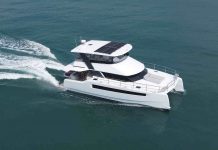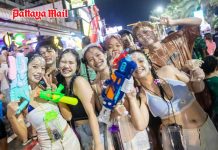 King Chulalongkorn, Rama V’s first visit to Europe, took place in 1897. In Milan, the King saw a statue of Italian King Victor Emanuel II which impressed him very much, saying it was “Very beautiful”.
King Chulalongkorn, Rama V’s first visit to Europe, took place in 1897. In Milan, the King saw a statue of Italian King Victor Emanuel II which impressed him very much, saying it was “Very beautiful”.
At the same time, His loyal subjects in Siam expressed their desire to honour the very popular King Chulalongkorn, Rama V, with an equestrian statue to celebrate the 40th anniversary of His accession to the crown. The cost of constructing the statue was estimated at Baht 200,000. People from all walks of life and nationalities donated funds towards this project. The total of which amounted to Baht 1.2 million. The surplus of funds from the donations was spent on building the Chulalongkorn University.
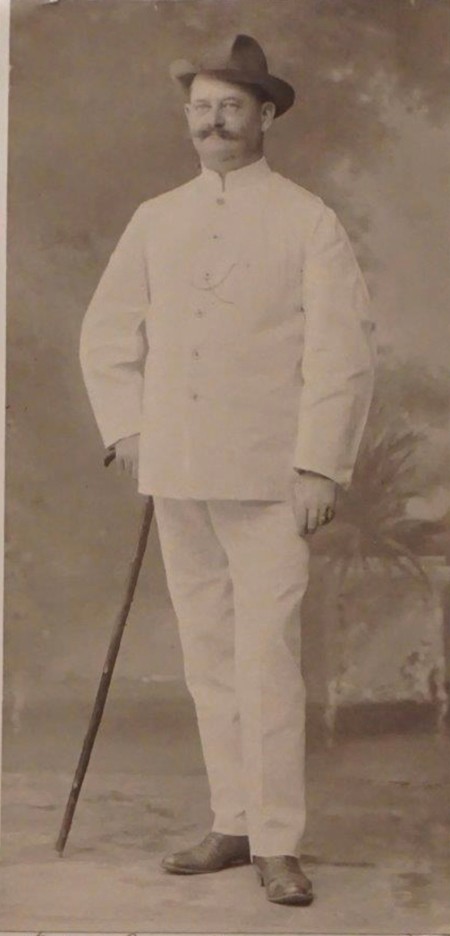
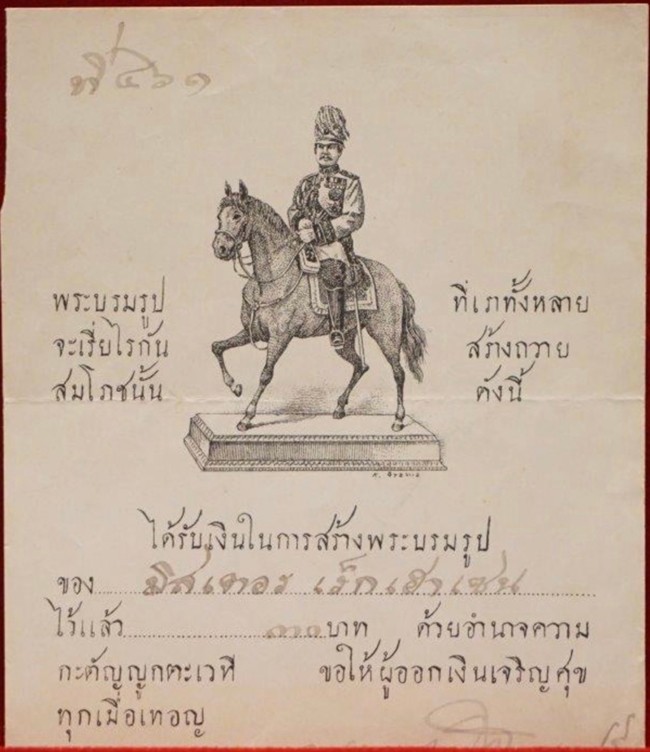
This is the translation of the receipt given the German diplomat and pharmacist Georg Friedrich Wilhelm Rexhausen for his donation 30 Baht.
Receipt No. 461
The equestrian Statue that all of us will raise funds to build in celebration of HM the King
Have received money for the construction of HM the King’s Statue
From Mister Rexhausen
For the sum of 30 Baht
With the power of loyalty and gratitude may the person who donated the money be blessed with prosperity and happiness forever.
King Chulalongkorn, Rama V visited Paris twice on his second journey to Europe in 1907. During these trips, His Majesty visited the Seusse Brother’s workshop where work had already started on the cast based on his photographs. Georges E Saulo sculptured the King’s figure and Clovis E. Masson sculptured the horse.
King Chulalongkorn wrote many letters from Europe to his daughter, Princess Nipha Nobhadol, whose nickname was Noi. The letters can be found in the book “Klai Ban” (Far from Home). In one of the letters he writes about his visits to the French sculptures:
“It is quite impossible to do a clay sculpture of a person when working only from a photograph, because the light and shade aren’t pronounced enough to give the true proportions of the face. The small model he made first was much too flat, and the larger one was hollow-cheeked, the skin looked wrinkled and sagging, and the mouth was rather puffy.
“But this sculptor really knows his job. As soon as your Father sat and posed for him, he straight away grabbed a lump of clay and started remodelling the head, then he corrected the face, putting clay on the cheeks to make them a bit fuller and patching up the temples in the same way. Then he smoothed out most of the wrinkles and corrected the eyebrows. But he had quite a struggle to get the mouth right.
“At first Father didn’t like the idea of having to sit for him, but after watching him do the first few bits of touching-up, I realized at once that it helped tremendously, and that dispelled my displeasure. Father so enjoyed watching him work that although he had asked me for pose for only an hour, I actually stayed for over two, and yet it wasn’t enough to get it quite correct. Time ran out and it had to be continued in Hamburg.
“I must say the French sculptors can work faster than the Italians; they are much better at getting a good likeness straight away.”
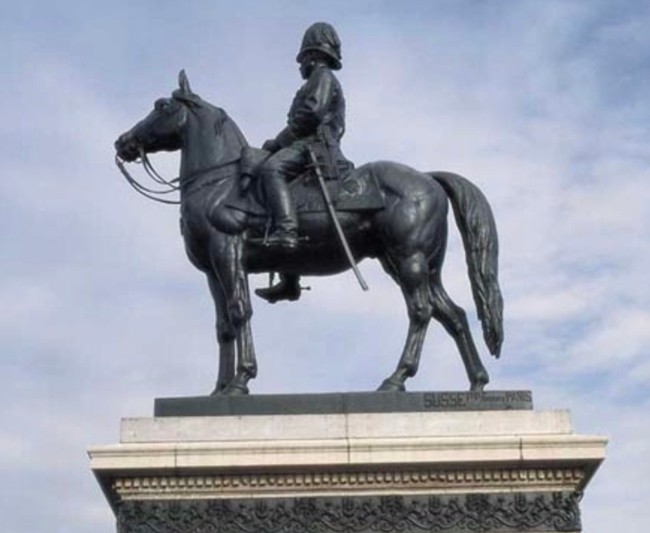
The statue was erected on November 11, 1908 and can be seen at the Royal Plaza to the south of Dusit Garden in Bangkok.
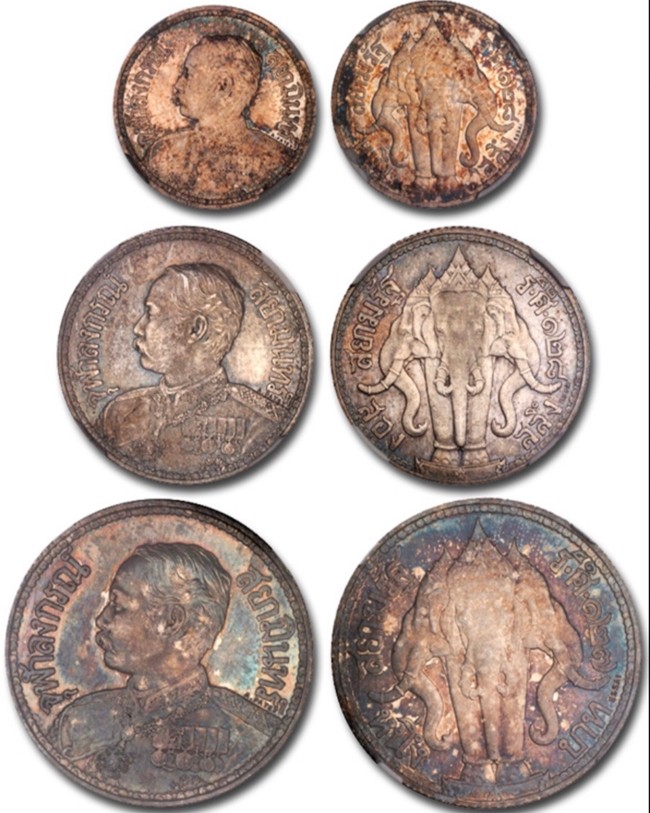 In 1907, King Rama V also visited the Paris Mint and met with the chief engraver Henri-Auguste Patey. In 1897 it was Patey who had engraved one of the medals marking the occasion of the King’s first visit to Europe.
In 1907, King Rama V also visited the Paris Mint and met with the chief engraver Henri-Auguste Patey. In 1897 it was Patey who had engraved one of the medals marking the occasion of the King’s first visit to Europe.
The Paris Mint was commissioned to produce a one salung (1/4 Baht), RS 128 (1909), a two salung (1/2 Baht), RS 128 (1909) and one Baht coin, RS 127 (1908). The three coins were produced as Essais patterns, with the portrait of King Chulalongkorn on the obverse and the reverse depicted the three headed elephant known as the “Erawan”.
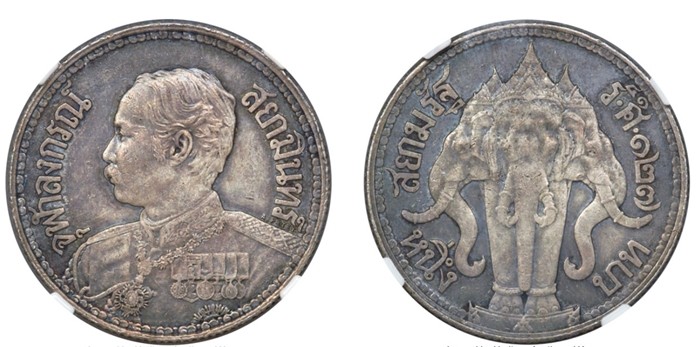
Only the One Baht was produced for circulation in a mintage of 1,037,000 pieces. Unfortunately, the coins arrived in Thailand after King Rama V died, so they had to be distributed at his funeral. After the King’s death most of these coins were destroyed.
The pictured coin was recently sold in Heritage Hong Kong auction graded by NGC, Numismatic Grading Services, as AU55 for US$6,600, about Baht 208,000. This coin from Dr. Norman Jacobs was estimated by Heritage to be US$3,000 to US$5,000.
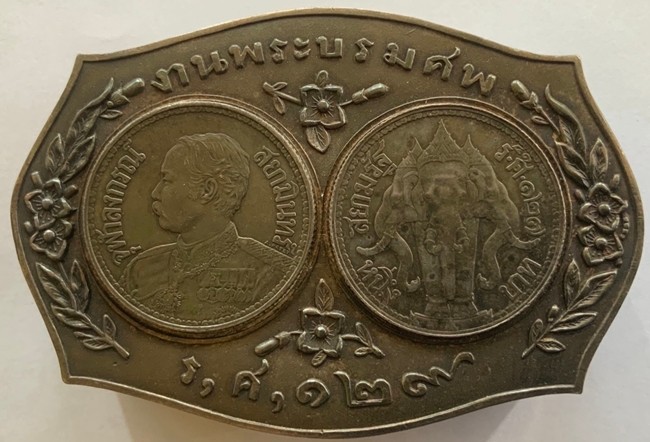
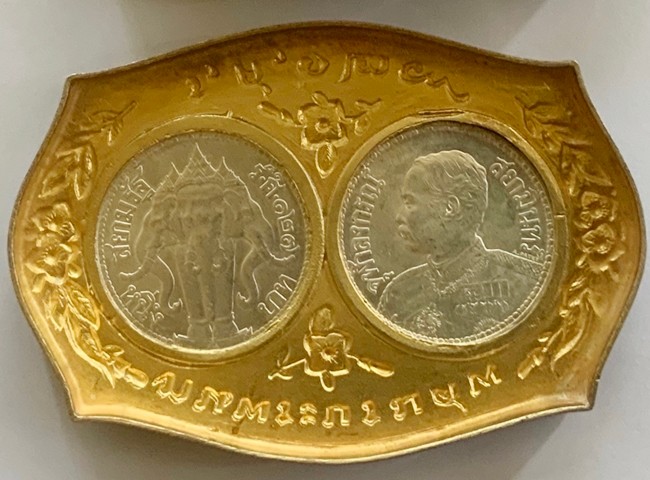
The One baht coins produced for circulation were also included in silver boxes. One contained one coin and another one containing two coins. They had the inscription “Royal Cremation of the King, RS 129” and the inside was gilded. Some of the coins included in boxes have been removed from the box. These coins do have a circle on the edge so for coin collectors they are less attractive and not as expensive as the ones with a perfect edge. Most of the coins appearing on the inside of the box are in almost uncirculated condition while the coins on the outside is in lesser grade because of handling of the box. It is recommended not to remove the coins from the box, as the value is higher in the box.
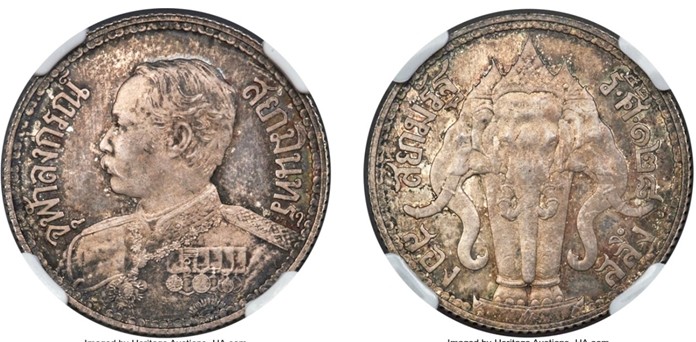
In the Heritage sale of Dr. Norman Jacobs, there was also the 2 salung, ½ Baht RS 128 (1909) Essai. This is probably the rarest of the three Essaias. It was graded by NGC to be MS64. The highest-grade coins are 70 grade, so this is a coin in very good grade. Heritage estimation for the coin was US$8,000 to US$10,000 but it sold for US$38,400, about Baht 1,200,000. My estimated sales price published in Pattaya Mail on May 22, 2020 was Baht 2,000,000. I assume it was a very happy buyer.
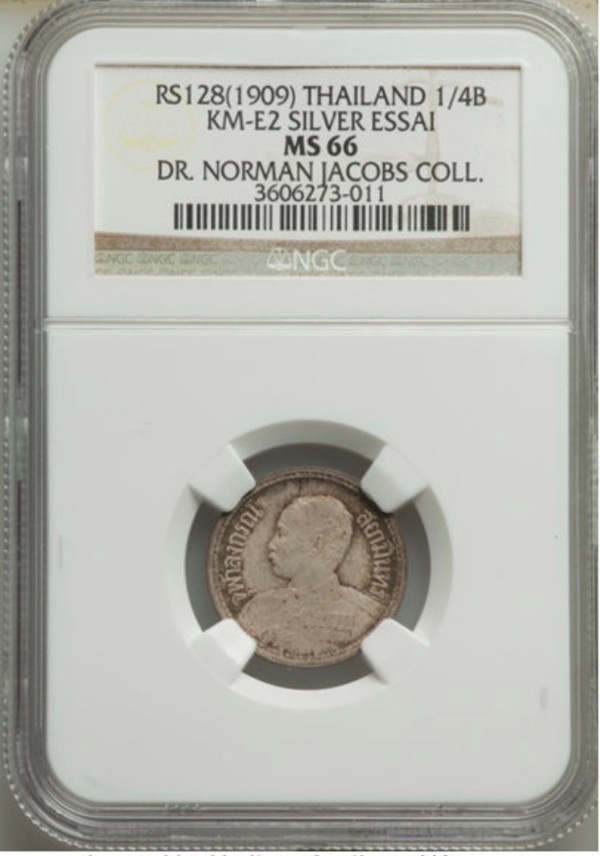
The one salung, 1/4 Baht, Essai was in the sale graded by NGC to be MS66 and estimated by the auctioneer to be US$8,000 to US$12,000. Probably the estimation was based on the high grade as this coin is not as rare as the ½ Baht. Smaller coins also have a tendency to sell for less than larger coins. The coin was sold for US$26,400, about Baht 830,000.
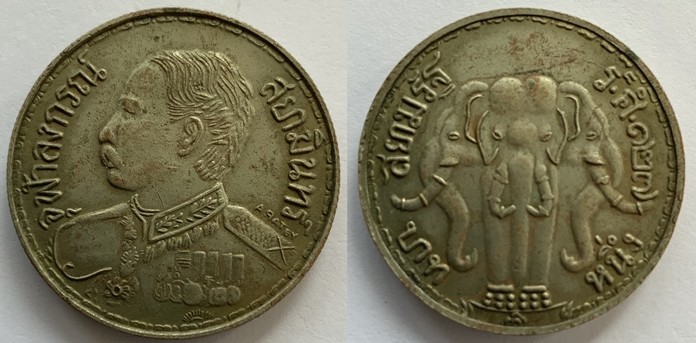
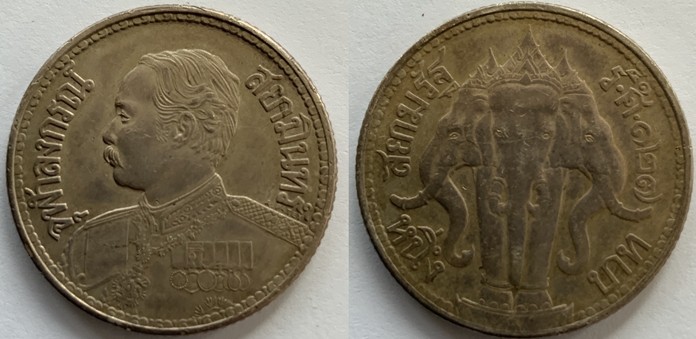
The one Baht RS 127, 1908, is a very popular coin as many collectors would like to have a memento from King Chulalongkorn the Great. Because of its popularity it is probably the most copied Thai coin. It is sold in markets for a few hundred Baht, but I have met buyers who have paid tens of thousands for a “good” fake. Be careful, pictured are two of the copies/fakes, which often are offered for sale. Do not believe the story: “My great grandmother took it out of circulation and was kept by the family from that time.” The coin was actually never put in circulation.
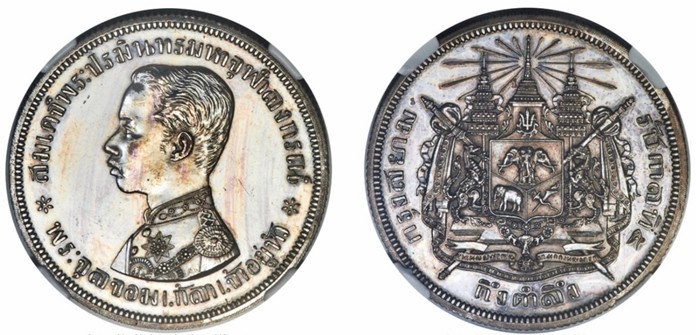
The most expensive Thai coin sold in the Hong Kong Heritage auction was Silver Proof Pattern 2 Baht, 1/2 Tamlung with no date (1877). NGC had graded it to be PR62, and the auctioneer’s estimation was US$10,000-US$20,000. The buyer had to pay US$78,000, about Baht 2,450,000 for this very rare coin. My estimated sales price published in Pattaya Mail on May 22, 2020 was Baht 2,500,000 to Baht 3,000,000. Looks like I was too optimistic.
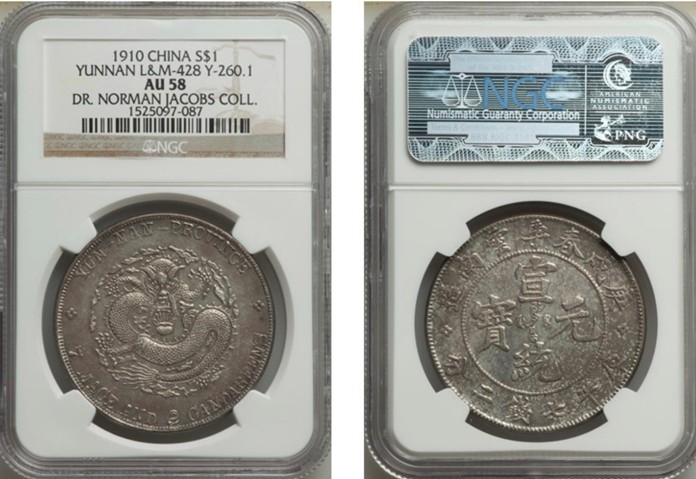
Heritage Auctions in Hong Kong announced that the revenue at the auction on July 12, 2020 amounted to US$ 5,369,066, about Baht 169,000,000. The most expensive coin was a Yunnan. Hsuan-tùng “Spring” Dollar CD 1910. It is called the “Yunnan Spring Dollar” in reference to the seven Chinese characters across the top that translate roughly to: “Made in the Spring 1910 in the Yunnan Province”. This is the only coin in Chinese Numismatics that features a season of the year as part of the year. The coin was graded by NGC to be AU58 and the buyer had to pay US$660,000, about 20,790,000 for this interesting rarity.
 |
 |
 |



